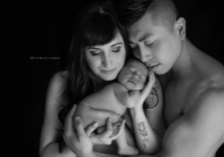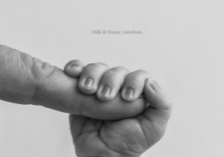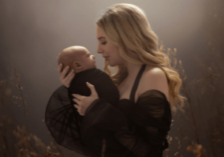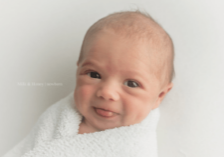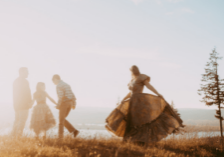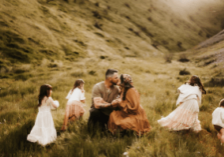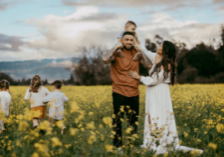Practicing Presence: The Healing Power of Slowing Down & Tuning into Mindfulness & Creativity in Photography with Joy Prouty
Do you struggle to feel present or embrace photography in your personal life? Just because something comes naturally to us as professionals doesn’t necessarily mean that the same is true at home. (Especially if you’re a mother of young children!) Sometimes taking photographs feels more like a chore or a nuisance than the beautiful and therapeutic art form that it’s meant to be.
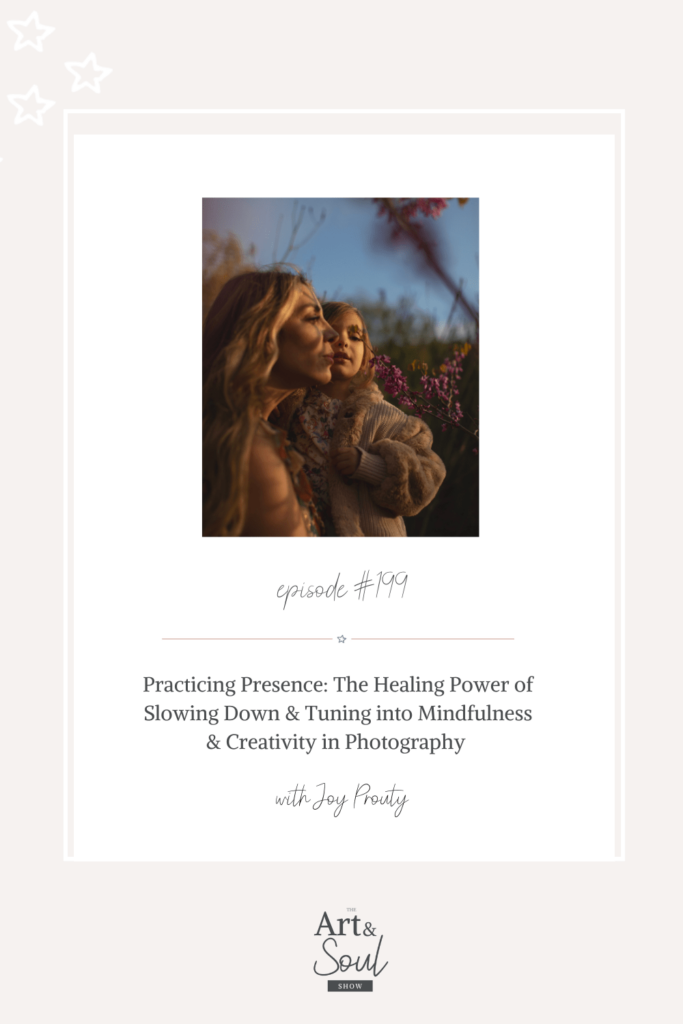
In today’s episode, I’m discussing this exact topic with professional photographer and author, Joy Prouty. Joy is an expert when it comes to photography as a vehicle for wellbeing and self-compassion in our daily lives outside the studio. Together, we explore everything from getting kids on board with our love of photographs, to leveraging affirmations and intention, to overcoming those things that hold us back. How do you take care of yourself through the process of taking pictures? Now’s your chance to find out!
So, get cozy, grab your notebooks, and tune in. I’m rooting for you, my friends.
What’s in this episode:
- [04:26] The inspiration for Joy’s book and how to embrace photography as a mother
- [10:42] Kids as reluctant subjects and showcasing photography as an art form
- [14:08] How photographers can learn to let go and overcome perfectionism
- [20:57] Using affirmations and intention to tell your brain what to prioritize
- [28:27] Slowing down and using the camera to promote mental health
- [34:42] Finding the bravery to share your images with the world
- [38:24] Avoiding comparison, procrastination, and self-doubt
Tune in to this episode to learn how to take care of yourself through the process of taking pictures.
SUBSCRIBE: Apple Podcasts | Spotify
Resources Mentioned
Meet Joy Prouty
Joy has been a photographer for 20 years. She’s also a mentor, educator, and now author of the new book Practicing Presence. She’s been a keynote speaker at Click Away, and a celebrity photographer who’s been featured in People Magazine, Magnolia Journal, Entertainment Tonight, and more.
Connect with Joy
Did this episode provide you with valuable lessons for your photography business? Check out this episode from The Value of Leading with Love (and how it keeps you moving forward) with Jadah Sellner that offers you even more insight on finding alignment in your business!
Transcript
[00:00:29] Lisa DiGeso: Welcome to the Art and Soul Show, where we dive into heart opening chats on photography, business, life, and that messy in-between. I’m your host, Lisa DiGeso, a mom, a photographer and entrepreneur. And I’ll be sharing honest conversations and advice for photographers with insight on mindset, entrepreneurship and creativity. The goal of this podcast is for you to be able to gain insights and strategies that will get you real results. Because let’s face it, having a photography business can be lonely, but it doesn’t have to be. This is the place you can go when you need a boost of encouragement, a kick in the pants and inspiration to pick up your camera. This is the Art and Soul Show. [00:01:11][42.2]
[00:01:11] Lisa DiGeso: Hello, my beautiful friends. Welcome back to the show today. I am so excited to dive into today’s conversation with Joy Prouty. Now, I have been following Joy for years, like probably close to 12, 13 years, way back on these online forums where before even Facebook forums and groups really existed. So I am so excited to actually sit down and have this chat with her. Now, if you don’t know Joy, Joy Prouty is at a photographer for over 20 years. She’s a mentor and educator. She’s a new author of an incredible, beautifully written book called Practicing Presents. She’s the keynote speaker at Click Away, a celebrity photographer featured in People magazine, Magnolia Journal and Entertainment Tonight. And, Friends, I am so excited to dive into this conversation. I just actually finished reading her book last night, and it’s so beautifully written. It is a mother’s guide to savoring the photos you’ve already taken. It’s about practicing presents, which, as an artist and a mother, I would absolutely recommend. So without further ado, here’s Joy. Welcome. [00:02:15][64.0]
[00:02:16] Joy Prouty: Thank you. Okay, I need to just listen to that intro. Beginning of every day when I wake up. This is my new affirmation. Yes. My inner thoughts are not speaking that way. [00:02:31][15.2]
[00:02:32] Lisa DiGeso: Oh, no. You are incredible. And like, here’s your way with words. Like, Honestly. I was just before we even got started, I was letting Joy know how much I loved reading her book. And there is like some tear jerker moments in there. It is just so beautifully written with so many actual steps at the end of the chapters on how to really be in presence and really embrace our photography and our lives and mothers. Because as we know, it goes so fast. But also, like the days are long, but the years are so short. So that’s one thing that I’m really, really starting to figure out. So I want to talk about your book to start there. Can you share what motivated you to write this book? [00:03:15][43.1]
[00:03:17] Joy Prouty: Well, I. I mean, I was working really, really hard, doing a lot of photography work. I was traveling across the country. I was gone for a lot of time away from my family in the in the years leading up to 2019. And I don’t think that that would have I don’t think I would have slowed down enough to be able to write a book if I hadn’t have gotten I got diagnosed with type one diabetes and then Covid hit and I had two babies. And it was just I felt like at times they would say and probably for a lot of people, maybe the debate around as long as you and me and in this community like it’s my time passed me like, like am I too late? Like, is that does this thing even resonate with me anymore? Does it even matter to people? And lots of like self assessment happening. And I, I have always loved writing and I felt like, well, maybe, maybe everything just it’s none of it is wasted. And in fact, it’s meant to be helpful in a different way. And so I, I started writing and I had been one I had been collecting the stories of my photography career and doing video for for a long time because I was able to be with people in the midst of like transition of dying and births and just lots of these very symbolic, important life experiences that I held this perspective of all of us as photographers, videographers, documentarians, we all hold this perspective that we’re watching some kind of miraculous thing happen before us. And our stories aren’t always told because they aren’t our stories to tell. But we’re walking around with these like, magical moments stuffed inside of us. And those are the things that make us not give up when we get really burned out. But I, I had all these stories and so I decided the book would be an excellent way for people to benefit for it, for, for all of the things that were like anything about me, that was just about my personal growth. Like it’s in there, but a lot of it got taken out so that what remains is very helpful for whoever is reading it. [00:05:39][141.5]
[00:05:39] Lisa DiGeso: So yeah, absolutely. It really was. It was for me, I’ve got a 14 year old, I’ve got an only child, the 14 year old. And so it’s been this really interesting relationship with my photography and my photography business and because I only have one. Regret, a lot of regret and a lot of almost shaming. And so what I really found was in your book is just sort of the permission just to kind of be like, you know what? It’s okay. It’s okay. You did the best you could. What You were trying to build your business. You’re trying to build your empire. At the time, you didn’t know you were only going to have one child. You tried to have more. That’s okay. So I feel like like I, I think this this book is such a good read, especially for new moms, just to, like, just stop. And I know, like, those days are so hard, but just just stop. And like, those little things that we forget. Like that hand on the cheek or that, like, you don’t know that that with a 14 year old, you don’t know that the last time you pick them off is going to be the last time. You know, like it’s heartbreaking. It’s heartbreaking. And so I really love I love the perspective of this book about slowing down. And the camera you have is the best camera to be using. So it’s like not shaming people for pulling out their cell phones. It’s not trying to talk everybody into buying a dSLR. It’s like, just shoot, Mama, shoot. [00:07:04][84.7]
[00:07:05] Joy Prouty: Yeah, I mean, thank you, Lisa, for sharing about that. Like, that’s really tender and vulnerable to talk about our choices and our regrets and how we’re living and we’re all just doing the best we can. And I have a I have just turned 15 year old boy also, so I totally resonate with so many of the things that you’re saying. Yeah, it’s a lot. But I think, you know, part of the things that have really helped me that we can still share with our kids no matter how old they are, because it’s I can I can easily fall into that scarcity mindset of like, oh, it’s too late with him or, you know, I can’t connect in that same way that I once did. Or it’s like we have to recalibrate into this new normal. And I think that we have more distractions than ever. And so we have to recalibrate into this new normal of this current time also, which is way different than when we first started raising our kids at 30 creative 14 years ago. And so to be present is hard because we often times like especially as documentarians like we thought, like we knew we that we were capturing something amazing, like in the present moment. That’s why we started taking pictures because we’re like, This thing is worth living for. It gives meaning to all that other the rest of this stuff. And so for me to find out, like the research behind the way our brains work in that the reason why that seems like the time is going by so fast is because our brains literally are not recording the memories. So the research, you know, like when I’m like, how come I don’t remember my son growing up? Like he’s 14? How where did I miss it? Right. What happened? [00:08:56][110.8]
[00:08:57] Lisa DiGeso: I know. [00:08:58][0.5]
[00:08:58] Joy Prouty: But it’s it’s that it’s that research about the neuroscience that if we are not present in our experiences of joy or beauty positivity, if we’re not living them, experiencing them, focusing on them for 20s each, they don’t even become a memory inside of our brain. But something that’s negative, it imprints in one second. So that was so shocking for me. And like justifying, validating to moms that like, Oh, this is why you can’t remember anything because we are we have so many requirements at every moment, at all times that we are never focusing on something for 20s No. But that our pictures, our pictures, they we can we can often return to that moment when we look at it because we often are staring at our subject for 20s. So it’s a magical portal that takes us back. [00:09:55][56.7]
[00:09:57] Lisa DiGeso: It’s yeah, it really does. And that’s one thing like I was it was funny because I was putting together a birthday video video for my son and I got mad at my husband and I was like, Why isn’t there not more video from when he was born when he was little? He’s like he’s like, phones didn’t have that yet. [00:10:14][16.9]
[00:10:15] Joy Prouty: Yeah. [00:10:15][0.0]
[00:10:15] Lisa DiGeso: Like what? Oh, of course. Of course. Right. [00:10:21][6.2]
[00:10:22] Joy Prouty: So crazy because you think we’re capturing it. Like if we’re like, Oh, let me get that before it leaves. Yeah, but it’s not even like it’s not going into our muscle memory. It’s not imprinting upon our brain. We’re not having an emotional experience because we’re not sitting in it long enough. So it’s actually just tons of wasted moments that we are not connected to. [00:10:40][18.7]
[00:10:42] Lisa DiGeso: Yeah. Hundred percent. And even even just pulling out your phone and camera, it’s always been sort of a very difficult relationship with my family because work was work. And so when my camera came out, it’s like, mom’s going to work. We all have to go to work. And, you know, like it’s the photographers child syndrome that we hear about. So I’ve always had sort of a reluctant little model where, you know, we’ve gone through priming. It got to a point where he was like, I don’t want you to take my picture anymore. And I’m like, I’m I got to respect that. So what advice do you have for like, maybe other listeners out there that are sort of struggling? They want to capture their family so desperately, but they have very reluctant subjects. [00:11:21][39.9]
[00:11:23] Joy Prouty: Yeah, I mean, it’s going to I think it’s think about what’s going to work for you because instead of thinking like, ooh, what’s this like magic trick for teens, which like, yeah, I don’t there is none. [00:11:35][11.4]
[00:11:37] Lisa DiGeso: Right. [00:11:37][0.0]
[00:11:39] Joy Prouty: Yeah. I mean I think it’s more like, well one tip for that is finding like exposing your children to so many different kinds of art and helping them start to have an appreciation for photography as an art form rather than photography as a method of torture. Yes, you have to change. You get to change the family culture around the purpose of photographs by modeling what it can be for you. So that’s why I wrote this book specifically to moms, because you are the visionaries of your home. You are the leaders. Like it is not true what everybody told you about be submissive and just follow. [00:12:22][43.2]
[00:12:23] Lisa DiGeso: No. [00:12:23][0.0]
[00:12:24] Joy Prouty: You are the leader. So rise and begin. So it starts with self validating through documenting your life by choosing to say I am a witness and he kids like I might have messed up in all these different ways, but I’m going to teach you self regulation through creative practice and this is going to benefit you and maybe help you process through a lot of those difficult feelings that I initiated in you. Sorry I broke you. This is how we’re going to fix it, right? You get to repair together, repair together. [00:12:56][32.0]
[00:12:57] Lisa DiGeso: Absolutely. Absolutely. I love how you said in the book about raising, you know, raising your children while also raising yourself, because that really resonated that, you know, we’re handed this baby and we’re just like inside. I often feel like I’m this 20 year old just with an older face and I’m trying to figure out this adulting thing so hard. [00:13:18][21.7]
[00:13:19] Joy Prouty: Like I now I all of us, I don’t know why we’re expected, didn’t know what to do. But then there you go. [00:13:25][5.7]
[00:13:26] Lisa DiGeso: So true. And even like looking at my parents, sometimes I’m like, Oh, like you’re just kids too. Guys like. [00:13:33][6.1]
[00:13:33] Joy Prouty: Yeah. I mean, that’s what that’s what presence allows us to do. Like, it’s the process of creatively learning to stop judging yourself so harshly. Yes. And if we can do it for ourselves, then we make space to be able to help others like to do it, for them to do it with them, to help make space to realize that they are not capable. And so I am. I hope that that’s what we can set a an example for that, you know, that we we didn’t see that. We didn’t know how to do that. [00:14:07][33.5]
[00:14:08] Lisa DiGeso: Yeah, no, it’s so true. So true. So I want to talk a little bit about the permission really, of letting go of those perfect pictures because as photographers and especially as a trained photographer, that’s really something that I struggle with is like, got to be perfect. And so what advice do you have for those that maybe struggle with that perfectionism to. [00:14:30][21.5]
[00:14:31] Joy Prouty: Well, it starts with, you know, when you take a picture that is not perfect of you when you look at it. So say someone took your picture. Hopefully, as documentarians, you are also prioritizing being photographed. And when you look at the picture, you know, like I even do this a lot with my family sessions is I do a lot of what I call after care planning and environment because I think of the photographic process as we have an opportunity to be reborn through this experience. This experience can be like a baptism for us. And that means that like if we are experiencing like a coming into understanding that this person that we see in the picture is us, is a portion of us, is maybe a masking portion of us is maybe trying to like keep it all together. Like, what do you see there? Look, be willing to look. Allow the new part of you that’s like being born through that, witnessing yourself to happen and like prepare that it’s going to be uncomfortable. Like, what is your aftercare plan like? Are you going to look at it like you before you even look? You tell yourself, I am not going to expect my body to look like when I was 20. I am not going to expect everyone to be looking at the camera and smiling. I, like you, have to really set the intention for the purpose of the photograph. And also it is so important to realize who told me that I had to look perfect in pictures. Work through that, Work through like who modeled for you that you can’t let your double chin show or your whatever. Fill in the blank. Hold everything like your hair should look like that. Or why it is that. Why did you do this kind of choice on this clothing or whatever? So photographs are doors that if we choose to open them, they reveal the deepest part of ourselves that need to heal. We can choose to be self healers through photographs. And if you are trying to make them perfect, you are. That’s okay. Maybe you’re not ready. You don’t have to open the door. But they can be more than what you’re making them. [00:16:50][138.6]
[00:16:51] Lisa DiGeso: Yeah, yeah, 100%. I’ve gone on a bit of of my own personal project this year where because I had a very reluctant model, I just decided, okay, well I’m going to photograph myself and it’s going to it’s been a really interesting self study this year. And I’ve been I’m a I’m very much a fine art photographer where I love compositing I love creating. Scenes in whatever is from my imagination and morphing myself into a character. But looking at those raw files and trying to look at them without that judgment has been wild. Like it’s been wild. But along the process, since January, I’ve actually lost 75 pounds. Wow. So it’s been like this whole transformative journey on how I view myself through the power of my lens. So it’s just been this absolutely wild journey of just like, learning to love yourself this year. [00:17:52][60.5]
[00:17:52] Joy Prouty: Incredibly cool. So, Lisa, do you have affirmations or intentions that you set for yourself or what is your process doing that? [00:17:59][6.8]
[00:18:01] Lisa DiGeso: My process is having fun, is letting that little girl who love to play dress up, put on a wig, do her do a her makeup, get into a scene and just have fun. And I think when I am true to that, no matter what I make, I’m going to be happy because I’m making it for me and I’m not making it for someone else. And so it comes to that sort of self validation that instead of that you talked about in your book is instead of like looking for those external sources like the cookies of the likes or the comments, yes, they’re wonderful, but I’ve already made it for me, so I’m already thrilled. Right. And however I look, I’m 45. Cool. This is what I look like at 45. [00:18:41][39.8]
[00:18:41] Joy Prouty: Right? Oh, you look really beautiful. I just really love that. The way that you’re saying that you’re doing it for you. Yes. And I think that’s so important like that. People remember it even put on your phone, like put a little piece of tape of some Sharpie that says, who is this for? Right. So when you lift your camera up to take a picture, you’re thinking, are you already looking for the best spot or the best version of you or like putting it down because it’s not some ideal. Or are you just going to do it for yourself? [00:19:14][32.6]
[00:19:15] Lisa DiGeso: Yeah. [00:19:15][0.0]
[00:19:16] Joy Prouty: So. And the more times we do it like that’s that the, that self validation research is so like blew my mind and I’m sure it did for you about how for all of us I mean women 100% we have been invalidated in so many different ways. And a lot of us, I think artists got into this career of doing this for other people because the validation from other people that we are making beautiful things or showing them things that were beautiful, that really was a salve for us, that we’re seeking some kind of someone to say you are you have this all of this worth, but then you do it for long enough and you realize like it’s not really working anymore, like what needs to happen here? And that’s when you realize, okay, if I don’t learn the art of self validation and start to validate myself, like, I’m not going to do this, I can’t make it. I definitely can’t make it. You know, there’s no there’s no possibility for connection with other people if I don’t figure this out, how to be healthy. And so the research in invalidation is that for every instance of invalidation, it takes 20 times of attuning to yourself to heal that specific wound. And so photography is such an amazing way of doing that because you can easily witness yourself 20 times in one occasion using photographs if you then sit with them and you’re like, Yes, I am worthy, I am valid to show up. This is a beautiful person. This is a good body. Then you’re you’re here. You are developing strength. [00:20:55][98.9]
[00:20:57] Lisa DiGeso: Yeah. I love that. I love that. And I love your affirmations. So can you share a little bit on how you found affirmations, how they worked for you, and when do you use them? Are you using them like in the morning, evening, all day long? [00:21:09][12.3]
[00:21:10] Joy Prouty: Yeah. So I intention is what I talk about in the book a lot. So affirmations like. Yes. Like affirming yourself, they’re so important. But I think on a on the realm of getting to the subconscious, like the part where it’s actually going to really benefit our brain, that’s where intention really comes in super powerfully. So, okay, I’m someone who really struggles with being in fight or flight mode. I think the majority of us do. Yes, you’re you know. [00:21:39][29.4]
[00:21:40] Lisa DiGeso: I’m just like literally ten minutes ago, I took a big chunk of, like, frozen meat. And I just like I had it on my chest was like, you were regulating. You’re a little wired right now. Like, come on, girl, We got to calm down a little bit. [00:21:51][11.2]
[00:21:52] Joy Prouty: Frozen meat. That is so good. Mine is usually like, what? It peas like. You better not squash squash in the freezer. So. Yes. Awesome. Great. Okay, so obviously you understand. So like, we are all. I mean, aside from like maybe childhood trauma stuff, there’s just like existing in the world right now. And like, for your mom, like they are teaching you all of the unhealed places within yourself. So fight or flight is like a place where I have existed with a very elevated adrenaline cortisol content. Like I definitely think that contributes to my autoimmune stuff. So many of us women with hormones like definitely it’s toxic for us stress. And so fight or flight is this thing where if we don’t figure out how to talk to our brain, so there’s this part of our brain called the reticular activation system, and it’s where all of our sensory input is happening. So like, ideally, we don’t want to like over flow it, right? We just want to like send in some lovely sensory things every so often and everything’s going to be great. And the reticular activation system doesn’t have to like do any hard work. But that’s not the world we live in. So there’s so much sensory information, so much sensory stuff going in the brain at all times that we have to use the power of intention to tell our brain what to prioritize. And so as an example, I talk about in the book, one particular morning we were watching this documentary about lions, and my son came up to me. He started talking to me and all of a sudden I realized he had this lion on his jammies, but he had worn those pajamas like 50 times before. I don’t know, maybe not that many, but a lot of times before. And I had never realized that there was a lion. But because I was exposing myself to all of this information about lions, my brain was like, Oh, okay, Joy. Joy is interested in lions. Now we’re going to be on the lookout everywhere for lions. And so if we can do that with positivity and this is this is basically the essence of manifestation, like in a brainwaves level is how can I So every day if I figure out what you’re struggling with, what are like, what’s blocking you? For me, it’s a lot of like self-hatred thoughts. And so I have to tell myself so that I don’t focus on negative things because it’s like, bam, bam, bam, bam. There’s a lot of imprinting of that going on. I have to be so intentional Every day of there is something good here right now, or you have joy, you have everything you need, like I don’t need to seek. So all of these things, these statements, right? So I’m telling myself I write them every morning ten times each. I put them in my phone, I do an alarm, I write it on my arm. I put it on the bathroom mirror like I’m trying to get that message into my brain as much as possible. And then throughout the day, I found I struggle with a lot less anxiety because of continually feeding myself the things that are true, because I didn’t know the battle that I was subconsciously fighting for. [00:25:14][201.0]
[00:25:14] Lisa DiGeso: I love that. I love that. Have you heard of the work by Byron Katie at all? [00:25:18][4.0]
[00:25:18] Joy Prouty: Yes. Yes. [00:25:19][0.6]
[00:25:20] Lisa DiGeso: Because I really I really love that. And that’s one thing from my own thought management that because I really do struggle with a lot of negative thoughts and I get into these loops too. But what I found with the work is it’s like a four step process where you’re questioning, is it true? And then how do I know for sure it’s true? And who would I be without this thought? And I can’t repeat the fourth one, but I yeah, there’s a fourth one. I butchered that. But my favorite part is who would I be without this thought? And when you start to visualize the person that you would be say, it’s like I’m untalented. This is something that I frequently bump up against. I’m not talented. I’m not talented. Like, no, I am talented. Or who would it be if I believed that I was extremely talented? How would I show up in the world? And when I live my life from that, my own thought management has been so much better versus getting stuck and looping in it. That’s switching it with write with affirmations and and it’s just it’s been so, so helpful. [00:26:25][65.1]
[00:26:25] Joy Prouty: Yeah. Because a moment becomes what we expect it to be and most often it is full of disappointment. So what I enjoy learning from is Scott Erickson, Scott the painter on Instagram, and he talks about how when we imagine what something’s going to be, oftentimes we’re imagining it without any of our vulnerabilities attached. So we’re thinking it’s going to be amazing, it’s going to be awesome. We’re going to have this experience, but we’re not imagining it in our actual vulnerable bodies with other people not meeting our expectations. And there’s no disappointment. And so we are setting ourselves up always to be disappointed. [00:27:03][37.2]
[00:27:06] Lisa DiGeso: It’s so true. [00:27:06][0.4]
[00:27:08] Joy Prouty: So it just goes to show us how much work you’ve done for yourself that you’re able to recognize those things. And it’s really wonderful that you’re practicing that. [00:27:17][9.4]
[00:27:18] Lisa DiGeso: And trying, trying. It’s funny, my birthday was last week and it’s funny because my husband and I, we always get into a bit of a birthday tiff right before or during after my birthday. And I went to my birthday this year and I was like, you know what? I’m going to have zero expectations of him. He doesn’t have to do he doesn’t have to do a thing. He doesn’t even have to wish me happy birthday. Because regardless, I am going to have an amazing day. And you know. Good morning. We should be happy birthday brought me. Got me a present. He was lovely. Got me flowers and it was the best birthday I ever had because I approached it without that feeling of having that expectation and then being disappointed because it wasn’t met. And you’re so right about like your brain and expectations, because when we take that away, we like that’s where joy is. Right? [00:28:06][48.2]
[00:28:06] Joy Prouty: Yes. Well, joy is only accessible in the present moment. You can’t time travel and experience joy. That’s beautiful. Awesome. I’m so glad you had a wonderful birthday. [00:28:17][10.2]
[00:28:18] Lisa DiGeso: It’s his birthday today. [00:28:19][1.6]
[00:28:20] Joy Prouty: And you’re working. You are having a good day, too. [00:28:22][2.1]
[00:28:23] Lisa DiGeso: I’m having an amazing day. Yeah. [00:28:25][2.5]
[00:28:27] Lisa DiGeso: Now, for many of us, there is this feeling of getting stuck in survival mode where our days turn into weeks. As working photographers, you realize you actually haven’t photographed your own family in weeks, if not months. Beyond that quick snap running out the door. So what advice do you have maybe for slowing down to want to pick up that camera when so many of us are burnt out physically, emotionally and creatively? [00:28:51][24.5]
[00:28:53] Joy Prouty: Yeah. Okay. Well, the first thing to go always when you’re in survival mode is creativity and imagination. Those things are like, extra and I think. I mean, this is you’re exhausted. So getting getting rest is so important. But I think if you can find some way to think about the act of taking pictures in a different way. So the reason you’re exhausted is because you are full of emotions and haven’t been able to be expressed and your immune system is low. Your body is exhausted. Right. But if you can think about photos as a way of entering into self-compassion to give you energy to sustain all of the work that you’re doing, like stop thinking about I’m going to grab my picture to take I’m going to grab my camera to take a picture and start thinking I’m going to grab my camera because I need to do my meditation or I’m going to grab my camera. So it’s like the camera can be a sub, a substitute for any other mental health practice. If you are choosing to use it with intention. So you have to start thinking like like a like a pen. We use a pen in a lot of different ways to write things, to keep track of finances. Like we do stressful things with the pen and work like things of the pen, but we can also write poetry with a pen. We can also sketch our child with a pen. So start to think about the camera as a tool for doing something different that requires you to actually become embodied rather than become disembodied and do a job. [00:30:35][101.7]
[00:30:36] Lisa DiGeso: Mhm. I love that. So it’s like literally a reframe. [00:30:38][2.4]
[00:30:39] Joy Prouty: Yes. [00:30:39][0.0]
[00:30:40] Lisa DiGeso: I love it. Love it. So I fell in love with photography, especially lifestyle photography. Years ago. But my experience photographing my own little guy. Really? It was, it was hard. And I think the experience of having an only child was really different because he would never independent play. He was just really keenly aware what I was doing, what attention I was paying to him that I really struggled with, like those in-between moments of him just doing something. Those are the moments that I was hoping to capture of him just being himself instead of just looking at me. So do you have any advice now that we are sort of approaching the teen years of approaching things in a different way? Maybe it’s my perspective. Maybe it’s how I approach him. [00:31:28][48.1]
[00:31:30] Joy Prouty: Does he care about photographs in any way? [00:31:32][2.7]
[00:31:34] Lisa DiGeso: He is like. And it’s like, Mum, don’t put that on Facebook, don’t put this on the Internet. And like, no, maybe like it’s just I just want to snap a photo of you just being you. [00:31:44][9.7]
[00:31:44] Joy Prouty: I mean. Have you put him in charge and let him take his own pictures? [00:31:47][2.9]
[00:31:50] Lisa DiGeso: You know, I haven’t. [00:31:51][0.5]
[00:31:51] Joy Prouty: It might be worth trying. Like, I mean, Christmas coming up may be thinking about getting a different kind of camera, like a Polaroid or a camera that he could use to explore the world around him so that he starts to see the value of taking pictures without it being, like, pushed on to him. Yeah, because it’s about creating a different family culture, right? So when you’re developing a different family culture, it’s okay, what have we all how have we all We’re even having a conversation with him about it too, would be really good. Maybe that’s like a dinnertime conversation. We talked about this as a family too. It’s like. I always fed you guys candy to get you to smile for the picture and blah, blah, blah in talking about these different things. And they’re like, Oh yeah, But like, I was thinking, Oh, I’m doing this damage. But the other day we were looking at all these pictures. We moved recently and found these chapbooks. You know, they had all of my old Instagram pictures and everything and they were like, Yeah, I remember that we had candy. But I also remember we had so much fun doing this thing. And so like, I think it’s important not only that we think about like, Ooh, how have we made our kids feel about photos? But also, first of all, give yourself grace for the way that photos used to be a thing before you learned about the importance of self-compassion and that you would remember everything that happened during the photo, but then also like get out old albums of when he was younger. And both of you together recognize the value of the family, pictures of the pictures that you guys had from when you were younger. Have him be just like, put them out on the coffee table. Let him discover them on his own and he’ll be laughing or smiling or looking at, you know. So then you’re like, Hey, what if we did like, let’s recreate one of those stupid pictures or like, even like, Hey, I would love to know how you see me. Like one year, two years ago, I asked my kids at Christmas the gift I wanted that from each of them was each of them to take a picture of me so that I could see who I was from their perspective. And so you just kind of get a little bit more creative about the way that you’re thinking about his engagement with the photographs. [00:34:00][128.9]
[00:34:02] Lisa DiGeso: I love that. And you mention that in your book, too, about, I think it was maybe your son Smith. Is that right? And he had you and you were you’re talking about when he looked at you, he had never seen you as like 20 year old Joy. He just knew you from where you are now as his mama. And I was like, oh, my gosh, you’re so right. They’re not looking at us as like when we were 20, 22. You know. Like this is your mom. [00:34:33][30.7]
[00:34:35] Joy Prouty: Yeah. And that’s amazing. Way more whole version than the version they might have at 20. [00:34:41][5.8]
[00:34:42] Lisa DiGeso: So, yeah, yeah. Yes, it was beautiful. I love that. I loved that. So I loved this quote from your book. When we take a photo, something we find interesting, we are proclaiming that our perspective matters. So often we get in our own heads that our own perspective doesn’t matter. What advice do you have about And for self-compassion and also bravery to share our images and our perspective with the world when we’re feeling really scared about it. [00:35:10][28.3]
[00:35:11] Joy Prouty: Okay. Well, first you go through that question of who is this for, right? Any time you’re about to post something that I mean, I think that’s probably the most important part to talk about that about is like, what mindset are you in before you’re about to share something that was vulnerably created through you? You know, like and when you think about art in that way that you’re at least planning to share with other people, you are claiming somehow that it’s like it’s coming from you, but it also is coming through you. Because if you don’t believe that in some way or like truly embody that belief, you’re going to hit imposter syndrome every single time. And so, like the cure to imposter syndrome is the understanding and like constantly centering yourself of realizing this is not just mine. I’m the carrier of this. And so then it became becomes a lot easier to talk about the work because it’s really important that you talk about the work that like, you know, like even me doing this book, like I worked on it, I put so much hard work into it. I put it out there and then like, it would be such a disservice to the work that came through me that is just partially mine. If I don’t talk about how important it is or, you know, share about the ways it came about and what I want people to feel or we wouldn’t be able to connect, you know, like that would have been neglected if I had kept it to myself or didn’t talk about it. And so, yeah, the like the ownership part is something to really think about. But as far as like being afraid. It’s my my fear of sharing is usually always based in scarcity mindset. Nobody’s going to see it. Nobody’s going to like it. I’m exhausted. Also, what? Where am I in my cycle that month? You know, like there’s so many contributors for so many games. That should be a way more talked about thing because it’s real and we’re somehow expected to just be like impenetrable. So yeah. Is that helpful? Is that. [00:37:23][131.6]
[00:37:23] Lisa DiGeso: Yeah. Absolutely. Absolutely. Actually, you hit the nail on the head, the cycle thing, because I’ve been talking recently with some 45 and perimenopause and there is so little information on moods, even like, I’m like, do I have Pmdd, which is like, you’re feeling really crappy the second half of your cycle. I tried going on progesterone wasn’t for me. And anxiety attacks like there’s so little information for women going through this and we’re expected just to like hustle along with this. My whole other thing there. Yeah. And I don’t want to do that. Don’t talk about it. [00:37:57][33.8]
[00:37:57] Joy Prouty: Yeah, well, that’s what you’re doing with your art, you know, And, like, how can we use our art? Like, because I start to feel that way, too. Like, who’s going to want to hear me talk? But then I’m like, Oh, wait, I got a superpower of making art. How can I make this through the imagery so that people are impacted in the way that, like, the the the miracle of life can only hear it through, You know, they can only hear it through the image. They could never just have the patience of waiting to hear me say it. [00:38:24][26.4]
[00:38:24] Lisa DiGeso: So, yeah, totally love that. All right. Can we talk a little bit about the comparison game? Because it’s that picture perfect Instagram feed where even the imperfect homes seem dreamy and yours feels like a train wreck on a good day. So we were actually went through a five year renovation when my son was about 5 to 10 years old. And I was so embarrassed and stayed at my house that I actually there are almost zero pictures during that that time period. And I do really quite regret it. So how do you get over that? How do you get over that feeling of like, everyone else’s home is amazing. Mine is this. Yeah. Well. Because if you see me and it’s gross and I guess it’s that self-compassion or ain’t I? [00:39:08][44.0]
[00:39:08] Joy Prouty: That’s a great question. And I’ve moved quite a few times and been in a state of transition like all the time I’ve lived in basically any house is because we renovate too, But like it’s not good until you’re ready to sell it and then you’re not, you know? Yeah. So, yeah, I mean, I think. When I look back, I have definitely seen. Like the seasons of depression lined up when the portions of that I haven’t taken pictures and so you can say one causes the other or you know flip it around Maybe the reason I’m depressed is because I’m not taking pictures. But either way, that’s connected. But I would say. The thing I’m telling myself lately, because we’re still living out of boxes and I don’t want to not take pictures, is I have to get to I have to reacquaint myself with the character of light that lives in this house. And so instead of thinking, I know what this picture is going to be like, okay, but I don’t know what the light what’s the personality of the light in this corner at this type of time of day? Where is the light wooing me? And then maybe just in those sections, like first it start to pay attention to the light. Okay? That it hits there. It hits there. Okay, maybe I want to put like a lace curtain there so that when that shadow hits, it’s going to be really interesting. It’s going to inspire me. It’s going to make me want to take a picture. So instead of thinking the whole house needs to be clean, I just am looking for these little pockets to create art in, so at least I have something to look forward to every day. And that is the spots of light. So like, you can even talk to the light, give it a name like a woman. Does she have this, like, really magical old lady, long, gray haired name, you know, like follow her around. Where is she taking you? [00:40:58][109.5]
[00:40:59] Lisa DiGeso: Yeah, I love that. I love that. Yep. [00:41:02][2.9]
[00:41:03] Lisa DiGeso: Our house would have the long haired, lady. [00:41:05][2.4]
[00:41:05] Joy Prouty: I wanted to know what you are on her. Come on. So let’s give her a name. [00:41:09][3.5]
[00:41:10] Lisa DiGeso: Oh. Hmm. That’s a good question. Helen just keeps popping into my head. [00:41:21][10.8]
[00:41:22] Joy Prouty: Helen. Helen sounds beautiful. [00:41:25][3.2]
[00:41:25] Lisa DiGeso: Helen. She’s like, fun and she’s elegant, and she. Yeah, she’s just like. She likes to dance. [00:41:31][5.4]
[00:41:32] Joy Prouty: Oh, gosh. I want to see where Helen dances. Take a picture there. [00:41:36][4.0]
[00:41:37] Lisa DiGeso: We’re going to find some pockets of Helen. [00:41:38][1.1]
[00:41:39] Joy Prouty: I like that. Okay. Really. Let’s see how this works. I mean, like, really. [00:41:42][3.0]
[00:41:43] Lisa DiGeso: I really will. So I won’t talk about self-doubt, procrastination, because this is probably my own biggest obstacle to my own creativity. It’s that little voice that says you’re stupid. Why are you trying to do that? It’s not going to turn out anyway, so why even bother trying? So it’s really struggling with that inner gremlin that I’ve really, really tried to work through over the past years. So do you have any advice to learn to ignore it and how to create from the heart? [00:42:09][25.5]
[00:42:10] Joy Prouty: Well, I think it’s kind of like what we were talking about before, about the like what is the nucleus of why you’re creating? You know, and so first, think about it on a personal level, because you don’t get clear about your why. Then you have no motivation to do the thing. And I can’t ever usually self motivate myself. So I have to think of like, okay, is that is this the discomfort of do if taking this picture and trying to attempt this thing possibly feeling like a failure, like whatever, is it worth it? Why am I doing it? And for me, it has to start with mental health. And so I think, okay, I’m doing this because it’s important for me to believe that there’s something here worth seeing, worth witnessing, worth documenting, and that I’m not the only one here. Like there’s all my kids are impacted by my energy. And so it’s a connection piece. So, you know, you just start naming all of those layers as to like you’re not creating because it’s selfish because that’s just the initial reaction. [00:43:11][60.8]
[00:43:12] Lisa DiGeso: Right? It’s just yeah, it’s like, oh, I should be doing something else with my time, that it’s better for my entire family instead of my little piece. Yeah. Which is to fully. [00:43:21][8.2]
[00:43:22] Joy Prouty: Acknowledge and document how it is beneficial for you to be in a creative headspace. It’s definitely going to help you solve a lot of problems throughout the day in a much more effective manner. So convince yourself. Write down an overwhelming list of reasons why it’s valuable for you to do that. And then we might put it next to the bed or whatever. You just you have to realize it’s so it’s deeper and deeper than what people are. [00:43:50][28.6]
[00:43:51] Lisa DiGeso: Yeah, it is. It’s deeper than just making an image that you think, maybe I’ll put this on the Internet and maybe I won’t. It’s deeper than that. It’s like I need to create because it fills my soul. [00:43:59][8.9]
[00:44:00] Joy Prouty: Yeah. [00:44:00][0.0]
[00:44:01] Lisa DiGeso: Yeah. Like that. All right, so you ready for our lightning. [00:44:04][3.4]
[00:44:05] Joy Prouty: Quick lightning round? Let’s do it. [00:44:06][1.3]
[00:44:07] Lisa DiGeso: Okay. If you like to cook, what do you like to cook the most? [00:44:10][3.4]
[00:44:12] Joy Prouty: Uh, chicken. Seasoned chicken with, like, chili lime salt, black pepper, garlic, little, maybe balsamic, like, very crispy on both sides. [00:44:22][10.6]
[00:44:24] Lisa DiGeso: Okay. Yum. Favorite movie. [00:44:26][2.3]
[00:44:28] Joy Prouty: Oh. Favorite movie. Okay. Moonrise Kingdom is this top pick. I never get bored of it. Now my kids are into it. And so we get to talk about filmmaking and all that kind of stuff. [00:44:41][13.6]
[00:44:43] Lisa DiGeso: I love that. Favorite guilty or not guilty Pleasure. [00:44:47][3.9]
[00:44:50] Joy Prouty: It feels. It feels guilty. But I know that it’s not. And it’s my called pledge practice going in the sea. We moved to an island a couple of months ago, and so we go in this sea and I sneak away by myself. And it’s definitely a mental health thing. But like now, sometimes I go in naked and that feels a little bit like a guilty pleasure, even though it’s benefiting my mental health in so many different ways. [00:45:13][22.4]
[00:45:13] Lisa DiGeso: You know. The studies that I’ve heard with the women have really like, I keep trying to jump in that shower and like turn it and crank it cold. And I’m just like, no. All right. So you’re a brave lady. I love it. [00:45:27][13.9]
[00:45:28] Joy Prouty: You got to find somewhere. Where do you live? [00:45:29][1.3]
[00:45:31] Lisa DiGeso: I live in British Columbia. [00:45:32][0.9]
[00:45:32] Joy Prouty: Okay. So you can find somewhere cold. You have to make it into more of an experience. You know, like those. Yeah. Artists like make it, like, into this very sacred outdoor experience. [00:45:44][11.2]
[00:45:45] Lisa DiGeso: So, yeah, I’m going to try that. And I’m going to try. Well, what did you want to be when you grew up as a kid? [00:45:53][8.3]
[00:45:54] Joy Prouty: I wanted to be a reporter. And I’m literally looking at myself with these headphones and a microphone right now. This is so funny. Like, yeah, I’m reporting on what is meaningful to people’s lives. [00:46:08][13.9]
[00:46:08] Lisa DiGeso: Yeah, I love that. I love that. And my next question is Oceans or Mountains and why. [00:46:15][6.1]
[00:46:16] Joy Prouty: The Salish Sea? I love whales. I love mice. I love the like, I feel like the ocean is like a woman, you know, telling us how to be. [00:46:25][9.6]
[00:46:27] Lisa DiGeso: I love that. What is something you’ve accomplished as an adult that your younger self would be proud of? [00:46:32][5.9]
[00:46:34] Joy Prouty: Having poetry published in a book would be my younger me would be really proud of that. So I have poet, I have poems in between each chapter. And so it was I had so many poetry books when I was little. [00:46:46][11.5]
[00:46:48] Lisa DiGeso: I love that. They’re beautiful. What are you most grateful for in this season of life? [00:46:53][5.3]
[00:46:56] Joy Prouty: My husband and I are on a healing journey together. So I think that we we are meeting in the middle after a lot of like, trying to find the roots of our pain for a really long time. And it feels really beautiful to be able to be hopefully setting the example of repair that our children are observing and to be able to do it through art is really something fun that we’ve been stepping into. [00:47:21][25.8]
[00:47:24] Lisa DiGeso: That’s beautiful. When do you feel most authentically yourself? [00:47:27][3.5]
[00:47:29] Joy Prouty: Uh, when I’m dancing, I think dancing by myself. Yeah. [00:47:36][6.8]
[00:47:38] Lisa DiGeso: And you know what I did last night is I actually made a playlist on Spotify, and I named it Forgotten Songs That I Love. And I went through, like, old 90s, like, 80s to thousands of songs that like the ones cause I’m pretty sure of it. And I will find a song that I will listen to it so many times that I now know all the words to the song, but then I’ll forget it and I’ll come up with a new one. So the list of like 150 songs that I’ve done with that, like throughout my life and I have the best playlist now is so great. I played it on the way to work today. It was unreal. [00:48:10][31.9]
[00:48:11] Joy Prouty: I love that. Oh, that’s such a good idea. Something I want to do that. To do it. [00:48:18][6.8]
[00:48:20] Lisa DiGeso: Do you have any personal projects going on right now? [00:48:22][1.9]
[00:48:22] Joy Prouty: I’m writing my second book, so that’s fun. I’m working on that and it’s requiring me to do a lot of self-portraits. So yeah, it’s self-portraits are really hard for me. They I mean, I feel like I have to endure this fire if I’m going to help other people understand the value of it. But. The technical part of it is really hard for me. I don’t like that. I like when I when I’m photographing people I love to be able to have full control over the focus. Like I use manual focus all the time. I mean, like primarily and I can’t have I can’t do that for myself, like with a self experience. And if feels like I’m having to get more creative with my craft in this way and I do not like that. [00:49:09][46.2]
[00:49:13] Lisa DiGeso: Self-portraits are hard. They really are. Actually. Have you tried the cam range? Cam Ranger Mini. It is something that you you click on to your camera and it’s an app on your phone. So wherever you are, you can set your camera and make sure it’s focused. [00:49:31][18.0]
[00:49:31] Joy Prouty: Oh yeah, yeah, yeah, I have. But it’s like for video too. Like, I’m just so connected that I just like, yeah, being able to, like, get closer and, like, move fluidly like this. But thank you. Yeah, I think I have, Yeah. Connect can connect or whatever. Yeah. [00:49:47][16.3]
[00:49:48] Lisa DiGeso: Yes. Something like that. Yeah. They’re super handy things. So what advice would you have for someone who’s first starting out with photography, whether it be business or just with a camera? [00:49:59][11.6]
[00:50:02] Joy Prouty: Notice what makes you come alive and notice what is makes you extra depleted of energy and do not do anything that pulls your energy anywhere down because there’s a lot of trying to prove yourself and not wanting to disappoint people. And when you’re working with clients, you don’t want them to be unhappy, but everybody’s going to end up unhappy if you’re shooting things that don’t feel authentic to who you are as an artist. So just get super, super clear into like how weird and quirky you want to be and just keep on walking down that road. [00:50:37][34.7]
[00:50:38] Lisa DiGeso: I love it. That’s such good advice. I love that. I wish someone had told me that in the beginning, because I’m loving when. [00:50:45][6.1]
[00:50:45] Joy Prouty: You’re in your weird and quirky self portrait era. [00:50:47][2.5]
[00:50:49] Lisa DiGeso: I love it. I love it. So where can our listeners learn more from you? [00:50:55][6.2]
[00:50:56] Joy Prouty: So you can find me on Instagram @JoyProuty. That’s where I talk a lot of my stories, and I share excerpts from the book and talk more about like, taking care of ourselves through the process of taking pictures. [00:51:09][12.9]
[00:51:10] Lisa DiGeso: Love that. So I love to end my interviews just with this last question. And it is, what are you currently curious about or artistically curious about? [00:51:18][7.9]
[00:51:20] Joy Prouty: Okay. Well, I guess I’m curiously artistic about lighting for self-portraits. You know, like an. Color casts in creating different like, you know, intent being intentional about different colors like I don’t know I it’s. Being a beginner at something again, because I’ve never done that before. So yeah. [00:51:42][22.6]
[00:51:42] Lisa DiGeso: I love that. Well, Joy, thank you so much for having this beautiful conversation with me today. I have treasured your time and I really appreciate you sharing yourself with our listeners. [00:51:53][10.6]
[00:51:53] Joy Prouty: I’ve loved it too. Thank you. [00:51:55][1.4]
[00:51:57] Lisa DiGeso: All my beautiful friends. I hope you have loved this conversation just as much as I have in sending you so much of my light and my love today and every single day. We will see you next time. [00:52:09][11.5]
[00:52:09] Lisa DiGeso: Hey, friend. You know, it’s the worst. It’s just being mid-session and completely freezing. You start to feel awkward. Your clients start looking at you for direction, and your brain feels like you just hit a wall. Now, believe me, you are not alone. And that’s why we created the Storyteller’s Toolkit. It’s an emotive prompt guide to help fashion stay free, flowing and fun. And best of all, right, now it’s totally free. It’s full of prompts for parents, motherhood, family, siblings and couples, and even surefire smile prompt. We’ve put together over 200 prompts for you, so you’ll never be at loss for an idea again. Grab your copy at themilkyway.ca/toolkit. [00:52:09][0.0]
[2962.0]
share the love
[Sassy_Social_Share]
recent
Podcasts
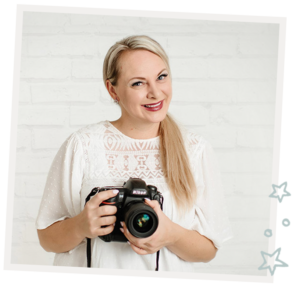
I'm
Lisa DiGeso
I’m on a mission to create uplifting online experiences for photographers ready to elevate their art, their business and their mindset.(...and have fun along the way!)












